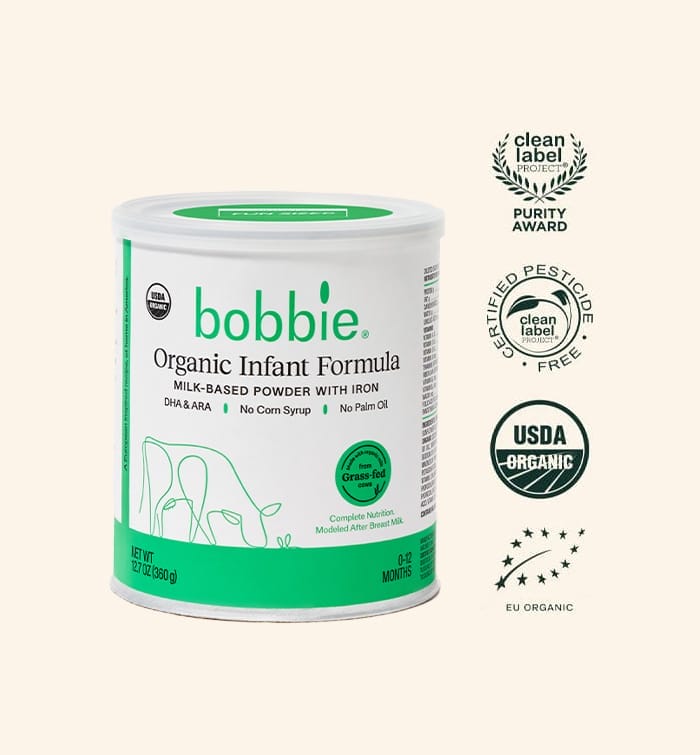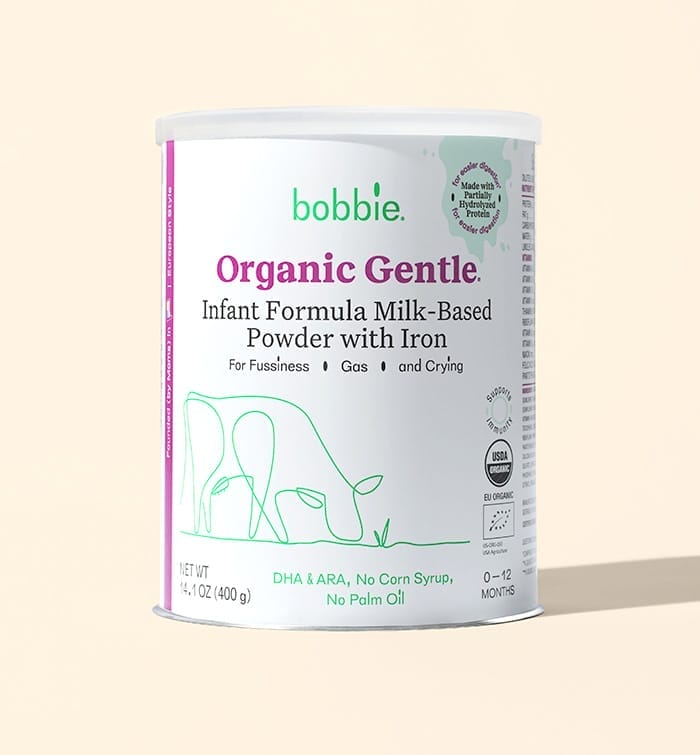We are proud to say that these posts are not sponsored. Our editorial team of Bobbie moms and writers personally select each featured product. If you buy something through our links, we may earn an affiliate commission, at no cost to you.
Choosing the right formula for your baby can feel like an impossible task. Standard, gentle, sensitive? Ready-to-feed or powder? What is MFGM in baby formula? What is GMO in baby formula? The list goes on! The good news? Choosing a formula is much simpler than you may think!
So much of how to choose a baby formula is personal. You can think about what stores are near you or if you prefer a formula subscription model that arrives at your house as needed. You can think about what price you’re able to spend, that may help decide if organic or non-organic baby formula is ideal, just like choosing brand-name versus store brand. With all of these choices, we’re here to help demystify the process of choosing the right baby formula for your baby.
4 Quick Tips for How to Pick a Formula for Your Baby
Ignore the marketing
The term “closest to breast milk” is an unregulated marketing term and it’s not quite accurate. First, there are certain components of breast milk that formula just can’t replicate, and second, all formulas must meet the same nutrient requirements and therefore are pretty much equal in that regard. What’s most important is that the formula works for your baby – not the label.
Skim the nutrition facts
All baby formula sold in the US is regulated by the FDA. The good news? All formulas are therefore required to include minimum (and some maximum) amounts of all vital nutrients. This means you don’t need to spend a ton of time analyzing the nutrition facts on the back of the can. It also means that when you are trying to decide how to choose a baby formula brand, that generic formulas are just as safe and functional (and promote optimal growth) like name brands do!
Look for these main ingredients in baby formula
How formulas source their nutrients (aka the ingredients they use to provide nutrients) can vary widely. The ingredients list is what you need to pay attention to! For example, protein may come from cow’s milk, goat’s milk, soy, or amino acids. Carbs may come from lactose, corn syrup, maltodextrin, or sucrose (table sugar). You have to read the ingredients list to know what is actually in baby formula— starting with identifying the main ingredients will tell you a lot about the formula you are looking at.
- Protein Sources
- Cow’s milk
- Goat’s milk
- Soy
- Amino acids
- Carbohydrate Sources
- Lactose
- Corn syrup
- Maltodextrin
- Sucrose
Note any extra ingredients in baby formula
Formula brands are always competing to differentiate themselves. One of the ways they do this is by offering new and exciting “extras” that lead parents to those desperate late night Google searches like “What is choline in baby formula?” or “What is HMO in baby formula?”.
Extras worth paying attention to include DHA and ARA as well as prebiotics and probiotics. These are all found in breast milk and have research supporting their inclusion in infant formula; however, don’t let a lack of these extras deter you from a formula that you are really excited about. If your preferred formula does not have DHA, prebiotics or probiotics, you can add them separately with approval from your child’s doctor.
What to Look for in Baby Formula

Shop Bobbie Organic Infant Formula
Bobbie Organic Infant Formula is a USDA Organic, EU-style infant formula that meets all FDA requirements. It is a complete nutrition milk-based powder modeled after breast milk and is easy on tummies. It is non-GMO and doesn't have corn syrup, palm oil, or maltodextrin. Learn more about Bobbie.
There are certain factors that we can prioritize when looking for a formula that is similar to breast milk. Here’s what we recommend looking for, in order of priority:
Lactose as the Carbohydrate Source
Short and simple: lactose is ideal. Why? Lactose is the carb source found in breast milk! Full-term, healthy babies are born with sufficient lactase enzymes and can digest lactose (either in breast milk or formula). As such, formulas with lactose as the carb source (in place of corn syrup or sucrose) are generally preferred among parents. When looking at the ingredients in baby formula, look for lactose to be one of the first ingredients listed. Check out the Bobbie ingredients list as an example.
While lactose as the carb source is generally preferable, some families may want or need a formula with alternative carb source, such as corn syrup or sucrose.
Alternative carb sources: While most infants tolerate lactose just fine, infants can have rare conditions that prevent lactose from being digested appropriately, including congenital lactase deficiency or galactosemia. In these cases, formula manufacturers must use replacement for the carbohydrates and the calories that are lost by removing lactose. Corn syrup, corn syrup solids, sucrose, and maltodextrin are common alternative carb sources. Note! The corn syrup you may see in baby formula’s ingredients list is not the same as the high-fructose corn syrup some adults are cautious to avoid. Please consult with your pediatrician if you have concerns about your baby’s ability to tolerate lactose
Protein Composition
Cow’s milk differs from breast milk in a number of ways. A big one? Breast milk contains significantly more whey protein. As such, baby formulas with added whey (near the top of the ingredients list) are generally preferable, especially when choosing a formula for a breastfed baby.
A higher ratio of whey protein has the benefit of making formula more easily digestible. By altering the type of protein (more whey, less casein) and the size of protein (intact, partially broken-down or extensively broken-down), formula manufacturers can achieve improved digestibility.
Outside of whey and casein protein types, protein size in baby formula comes in a few forms: intact, partially-hydrolyzed, and extensively-hydrolyzed.
Intact proteins- These proteins are what you find in a standard or routine cow’s milk formula. Intact proteins are a great place to start when choosing a baby formula for the first time as most healthy, term infants can digest them.
Partially hydrolyzed proteins– These are the proteins found in ‘gentle’ or ‘tolerance’ formulas. The proteins (either whey or casein) are partially broken-down (or “pre-digested”) to a smaller size than are naturally occurring in cow’s milk, making the formula easier to digest. These formulas often have added whey or use 100% whey protein.
Extensively-hydrolyzed proteins- These proteins (either whey or casein) are extensively broken-down and are found in hypoallergenic formulas for use in infants with cow milk protein allergy.

Shop Bobbie Organic Gentle Infant Formula
Bobbie Organic Gentle is the only baby formula in the U.S. market that offers 100% partially-hydrolyzed whey protein and 100% lactose as the carbohydrate source. Our gentle baby formula is easy on sensitive tummies to help alleviate fussiness and gas. Learn more about Bobbie Gentle.
Additional Considerations
Now you know that a great starting point is to look for a formula with cow’s milk as the protein source (with added whey!) and lactose as the carbohydrate source. Let’s take a look at a few other factors to consider when selecting a formula for your baby:
Formula Availability: When starting baby formula, ensuring you can consistently find the same brand is important. Especially given the recent formula shortage, you might consider using a formula like Bobbie that offers a guaranteed monthly subscription. And remember– while nutrients in all baby formulas are the same, the ingredients list will vary. Staying as consistent as possible will be easier on your baby’s tummy, while saving you a lot of stress and frustration.
Ingredient Quality: Some parents have strong desires when it comes to the way their baby’s formula ingredients are grown and manufactured. In this case, looking for designations like “organic,” “grass-fed,” and “non-GMO” might be important. Additionally, certain awards like the Clean Label Project Purity Award or Pesticide-Free Certification can provide comfort for families looking for an exceptionally clean product.
Extra Baby Formula Ingredients
These ingredients are found in breast milk and can be found in some formulas, or in some cases, added separately.
DHA and ARA: DHA and ARA fatty acids are naturally occurring in breast milk and have been shown to promote vision and brain development of newborns. (*Can be added separately)
Lactoferrin: Lactoferrin is a protein found in breast milk that aids in supporting digestive health and iron absorption, with the highest concentrations being found in colostrum, or ‘first milk.’
MFGM (Milk Fat Globule Membrane): MFGM is a naturally occurring membrane that surrounds the fat molecules in breast milk and is believed to contribute to cognitive development.
Probiotics- Probiotics are live cultures that maintain or improve good bacteria in the digestive system. (*Can be added separately)
Oligosaccharides (Prebiotics)- Prebiotics feed the growth of healthy bacteria in the gut. (*can be added separately).
HMO (human milk oligosaccharide) is a naturally occurring prebiotic found in breast milk that is often added to baby formula.
Choline- A naturally occurring nutrient in breast milk that aids in brain development
Special Baby Formula Considerations
The sheer number of baby formula options on the shelves can be overwhelming. If you have been exploring and researching infant formulas, it is likely you’ve also seen soy formulas, European formulas, and toddler formulas alongside the big name infant formula brands. Curious about how they compare?
Soy baby formula
The American Academy of Pediatrics (A.A.P.) has strict criteria for when a soy formula should be used:
- In cases of food allergy when hypoallergenic or elemental formulas have not worked.
- In cases of Galactosemia.
- A religious or cultural need for a plant-based option.
Because of concerns about phytoestrogens in soy protein, soy formula is often recommended as the very last step rather than a starting point. There is almost always a non-soy, workable option if traditional cow milk formulas haven’t worked for your baby. Please consult with your pediatrician if you are considering using a soy formula!
European formula
Many European baby formulas are not regulated by the FDA and are not permitted to be sold in the U.S. Even so, some parents choose to import E.U. formulas. Always talk to your pediatrician if you’re considering a formula that is not FDA-regulated. NOTE: In response to the recent baby formula shortage, the FDA is allowing the import and sale of some European formulas in the US market under enforcement discretion. A list of imported formulas that ARE registered with the FDA under their “enforcement discretion” pathway can be found on the FDA website.
Toddler formulas
Some formula brands bypass FDA regulations by labeling their products as “toddler formula”. On the whole, toddler formulas are not recommended and do not meet FDA requirements for infants under 12 months. Check with your pediatrician before considering using a toddler formula, particularly under 12 months as this is not routinely recommended.
Overview of How to Choose a Baby Formula
The best baby formula is the one that works for your baby. Despite many marketing strategies that aim to differentiate one formula from another, the truth is that all infant formulas on the market are nutritionally-complete and promote healthy development. It can take a bit of trial and error to figure out what will work best for your baby; be patient, seek help and support when you need it, and know that you’ve got this.

